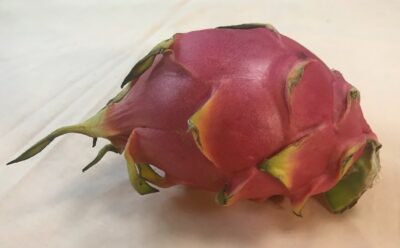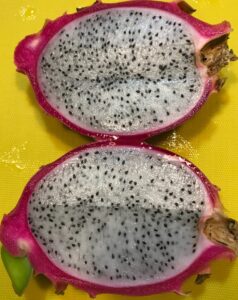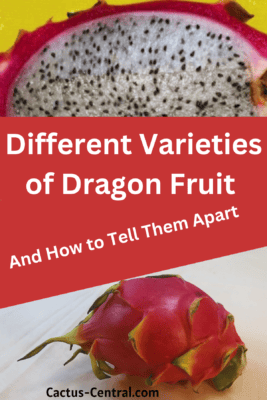This post contains affiliate links.
Dragon fruit is a tropical fruit that has taken the culinary scene by storm. Many may not know that dragon fruit comes from a tropical cactus plant and that there are many different species of this cactus. Not only that, but the fruit also comes in several different color variations depending on the species or the hybrid.
There are many different types of dragon fruit out there since it is quite easily hybridized, and so it can be difficult to know exactly how many there are. Some dragon fruit species are: H. undatus, H. triangularis, H. costaricensis, H. polyrhizus, H. ocamponis, H. megalanthus, H. triangularis, and Acanthocereus tetragonus.
From these species and the hybrids that come from them, we have a wide variety of dragon fruit to choose from, whether it’s the fruit we’re interested in, or the plants themselves.

The Different Species of Dragon Fruit
Dragon fruit is also known as pitaya and is one of the most popular exotic fruits available today. You can find it in grocery stores as fresh fruit in the produce section, served in coffee shops as a refreshing beverage, and even bottled and sold as a juice but many people may not know that there are many different species (and hybrids) of dragon fruit.
Not only are there different species of dragon fruit, but they can also come in different colors from a pinkish-red skin fruit with white pulp to a red/magenta colored skin with deep red colored pulp or even a fruit with yellow skin and white pulp. There are also slight differences in their taste too, depending on the type.
The fruit is full of antioxidants, vitamins, and minerals. They even sell it in powdered form for smoothies, or as a superfood supplement. This one on Amazon is just one example.
Even though there are many different types of dragon fruit, there are only four species that are widely and commercially grown around the world for their fruit. These are H. undatus, H. Costariscensis, H. megalanthus , and H. polyrhizus. (reference) There are also many different cultivars (hybrids) of these species.
Generally, these are the types of fruit that you will find in your grocery stores.
We have another article showing how you can grow your own dragon fruit plant from store-bought fruit. Check it out if you are interested.
Dragon Fruit With Reddish-Pink Skin and White Pulp
Hylocereus undatus
The white dragon fruit, Hylocereus undatus, is probably the most common type found in our grocery stores. This fruit has a bright reddish-pink skin on the outside with a white pulp on the inside. There are many tiny black seeds in the pulp. (These seeds are also edible). It has a taste that is similar to that of a kiwi.

There are many different cultivars of this species, some of them with a sweeter taste, some with a tangier taste, and even some that taste more like a melon.
For those that would like to grow their own H. undatus dragon fruit, check this one out on Amazon. It comes as a 12” plant that has already been started for you and is self-pollinating.
Hylocereus triangularis
This is another dragon fruit that looks similar to the H. undatus. The skin is reddish-pink and the pulp is white with black seeds. The fruit is smaller than the H. undatus. It is often called “Strawberry pear”.
Dragon fruit with Red skin and Red Pulp
Hylocereus costaricensis
The skin of this dragon fruit is a red-fuschia color on the outside with a pulp that is a deep red-magenta color.
This species is known for having some of the largest stems of the dragon fruits and these stems are very heavy.
This species of dragon fruit is one of the 4 species most commercially grown around the world.
Amazon has these seeds for you to germinate your own H.costaricensis dragon fruit plants.
Hylocereus ocamponis
This species has a red skin and a pulp that is red-magenta. This is one of the species that can self-pollinate.
Dragon Fruit with Yellow skin and White Pulp
Hylocereus megalanthus
This species has yellow skin with a white pulp. This is also one of the species that is commercially grown around the world.
If you are interested in growing your own H megalanthus, Amazon has these ones. They are sold as small plants that are about 3-8” tall.
Cereus triangularis, (Hylocereus triangularis)
This species also has yellow skin with a white pulp.
Information About The Dragon Fruit Plant and Flowers
Dragon Fruits are part of a larger family of cactus plants that are often called night-blooming cereus, or queen of the night.
Some people grow night-blooming cereus plants just for the flowers since they are strikingly beautiful and very fragrant. The blooms are, unfortunately, short-lived since they only last one night, but each plant usually has multiple flowers that also bloom over a period of time.
Note: Since they bloom at night, they are generally pollinated by bats, moths, or ants.
Dragon fruit flowers are one of, if not the largest flowers of the cactus family. The blooms are generally pale, or white with yellow anthers, yellow-green stigma, and yellow-green outer tepals. There are some types that also have tepals with a hint of red. The size of their flowers vary slightly depending on the species (or cultivar) but all of them are large in size.
For those that are interested, we have several other articles about flowering cacti and succulents: Bunny Ear cactus, Christmas cactus, Jade plants, Old lady cactus, Old man cactus, and succulents.
Here’s a table showing the species of dragon fruit along with the skin, fruit, and flower colors.
| Dragon Fruit Species | Fruit Description | Skin Color | Fruit Color | Flower Facts | Links |
| Hylocereus undatus, also called Selenicereus undatus | Oval-shaped, elongated, and 4-6” (10-15 cm) in length | Reddish pink/red | White with black seeds | White petals with yellow anthers and yellow-green stigma in the center. Yellow-green outer tepals and bracts.14-15.4” in length, (23.6-39 cm) | IFAS Extension, University of Florida |
| Hylocereus triangularis, also called Hylocereus trigonus & Selenicereus triangularis | Oval-shaped, 4” (10 cm) in length | Reddish pink/red | White | White petals with yellow anthers and yellow-green stigma in the center. Yellow-green outer tepals and bracts. 8” in length, (20 cm) | Exotic fruits and vegetables NYBG STEERE HERBARIUM |
| Hylocereus costaricensis, also called Selenicereus costaricensis | Oval to elongated, rounded tips 3.6” (9.27 cm) in length | Red/ Fuschia | Red/Magenta | White petals with yellow anthers and yellow-green stigma in the center. Yellow-green outer tepals and bracts.8.7-12.6”, (22-32 cm) in length | Wikipedia |
| Hylocereus polyrhizus, also called Selenicereus polyrhizus | Oval to elongated | Red/Magenta | Red/Magenta | White petals with yellow anthers and yellow-green stigma in the center. Yellow-green outer tepals and bracts.10.9”, (27.8 cm) in length | Horticultural Science and Technology |
| Hylocereus ocamponis, also called Cereus ocamponis, Selenicereus Ocamponis | Oval-shaped, elongated2”, (5 cm) in length | Red | Red/Magenta | White petals with yellow anthers and yellow-green stigma in the center. Yellow-green outer tepals and bracts, may have red/pink on outer tepals.10-16”, (25-30cm) in length | Exotic fruits and vegetables |
| Hylocereus megalanthus , also called Selenicereus megalanthus | Oval-shaped, elongated | Yellow | White | White petals with yellow anthers and yellow-green stigma in the center. Yellow-green outer tepals and bracts12.6- 15”, (32–38 cm) in length | Garden.org Plant Database |
| Cereus triangularis, also called Hylocereus triangularis | Triangular, segmented2”, (5 cm) in length | Yellow | White | White petals with yellow anthers and yellow-green stigma in the center. Yellow-green outer tepals and bracts7.9-9.8”, (20-25 cm) in length | The Cactus Expert |
| Acanthocereus tetragonus, also Cereus pentagonus | Round to oval2”, (5 cm) in length | Red | Red | White, outer tepals are greenish-white, inner tepals are white and pistles are creamy-yellow5.5-7.9”, (14-20 cm) in length | Exotic fruits and vegetables Wildflower.org |
Please note that this table provides general information, and there may be variations within each species and even more so with hybrids of these species.
This post was written for cactus-central.com and is not permitted to be used on other sites.

